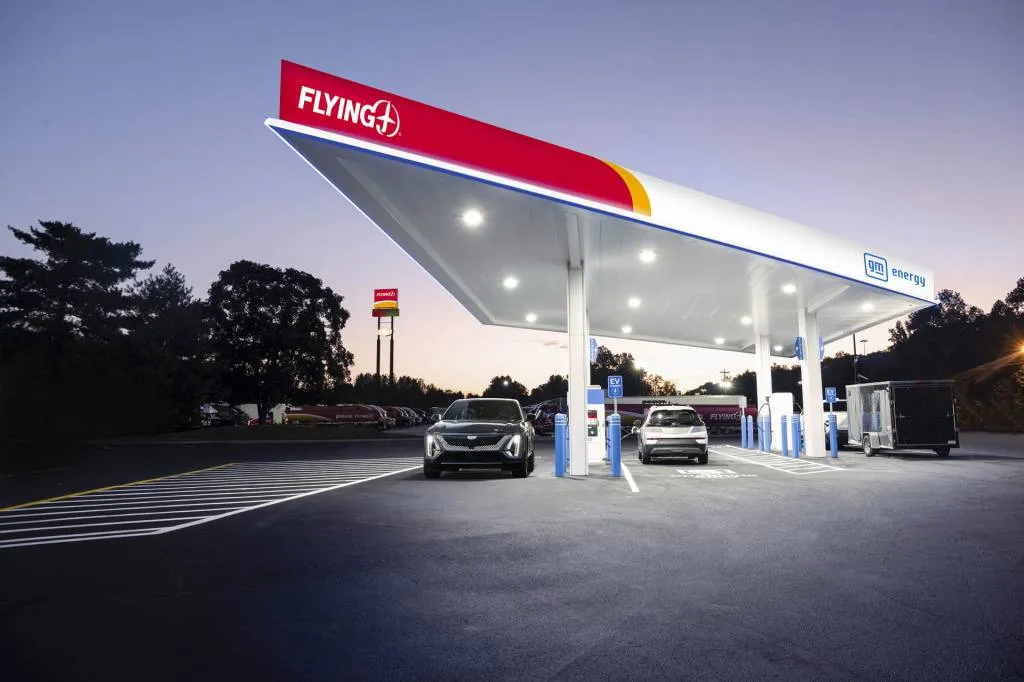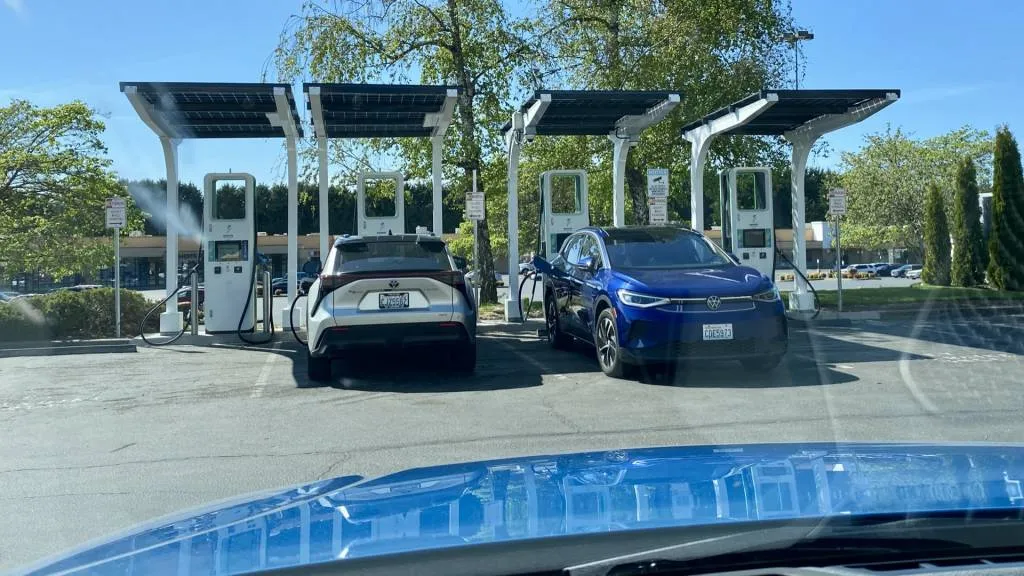EVs and charging stations have aspired to provide EV drivers with something that rivals the turnaround time of gas stations.
While charge rates are important, reliability and simply being able to get a charge, ultimately, are perhaps more important points that some charging networks seem to have glossed over in the process.
According to a 2023 study, roughly 20% of EV public charging attempts fail. On the other hand, if there’s an issue at a gas pump that appears operational, it might run a little slower, but it typically won’t shut down completely, rendered inoperable.
A group of U.S. Department of Energy Oak Ridge National Laboratory (ORNL) researchers have kept that idea in mind with a project. They seek to get EV charging closer to that gas-station experience—by aiming to add resilience around two typical issues at high-power charging stations. And it appears building a little more flexibility into the station layout and controls might be all it takes.
Electrify America station with 2 of 4 chargers inoperable – April 2024
Experts: EV charger shutdowns often unwarranted
As ORNL pointed out in an update on the efforts earlier this month, either of the two issues focused on by its team of researchers—sudden voltage drops to the station, or power fluctuations within chargers—can be remedied in a way that doesn’t shut out chargers until a maintenance visit or remote restart.
The solution to one of them, a sudden voltage drop, is as easy as a “ride through” algorithm that restores power seconds later when it typically returns. As they point out, that not only helps the end user but also helps assure there isn’t a corresponding voltage surge.
Presently, such a voltage drop can render chargers useless, requiring a maintenance visit to re-activate them when the equipment is fine.
Inside the charging cabinet, a charger may also shut down due to a fault when one of its three power modules has an issue. According to the researchers, looking at algorithms, it would better serve customers who simply need a charge if the control strategy allowed the other two to compensate somewhat and provide reduced overall power until a repair, rather than shutting down.
You’d be more satisfied if you got a charge, with an apology that is was a bit slower than usual, rather than no charge at all, right?

GM and Pilot Company’s EV charging network
EV charging stations need to be more gas-station-like?
For better reliability taking advantage of these ideas, the researchers point to a different kind of layout versus present-day charging stations—with a “multilayered approach for control and communication” across a charging station that “resembles a gas station with many pumps.” At it, a system-wide controller would alter equipment settings based on issues at individual chargers, to maximize performance and uptime.
The federal government is tackling EV charger reliability in the U.S. infrastructure buildout, and through its Charge X consortium it’s already focused in on several aspects that amount to a tangle of technical barriers, including non-standardized error reporting and payment issues.
It’s not surprising that automakers have stepped forward, opting to create their own networks in some cases—like the upcoming Supercharger-rivaling Ionna—rather than ally with existing ones. Rivian has even adopted a grading system for public chargers that will be used for its own dynamic route planning.

purchase lasuna online cheap – buy generic lasuna over the counter himcolin without prescription
buy generic besifloxacin – besivance online order cheap sildamax
gabapentin order – oral azulfidine 500mg sulfasalazine 500mg oral
buy benemid without a prescription – buy generic tegretol 200mg carbamazepine 200mg ca
buy celebrex pill – cheap urispas generic purchase indomethacin generic
voltaren 100mg oral – brand cambia buy cheap generic aspirin
buy rumalaya pill – rumalaya buy online buy endep for sale
order mestinon 60 mg without prescription – purchase imitrex without prescription azathioprine 25mg canada
Стильные заметки по подбору отличных луков на каждый день.
Обзоры профессионалов, новости, все коллекции и мероприятия.
https://emurmansk.ru/pub/2024-09-10-demna-gvasaliya-revolyutsioner-mody-i-kreativnyy-provokator/
buy diclofenac generic – diclofenac canada purchase nimodipine
buy generic baclofen 25mg – lioresal order online purchase feldene online
buy meloxicam 15mg online – toradol medication buy ketorolac pills
buy cyproheptadine pills – purchase cyproheptadine pill buy generic tizanidine 2mg
artane online order – buy artane generic order emulgel sale
cefdinir 300mg cost – how to buy cleocin
accutane 40mg over the counter – buy aczone online cheap order deltasone online cheap
buy deltasone 5mg for sale – zovirax for sale purchase zovirax sale
permethrin online order – benzac order online tretinoin gel tablet
betnovate oral – buy generic betamethasone over the counter order monobenzone online cheap
buy generic flagyl – order metronidazole 200mg sale cenforce 50mg pill
order augmentin 375mg generic – amoxiclav for sale levothroid canada
brand cleocin – order indomethacin pill buy indocin 50mg generic
order losartan online – purchase hyzaar sale keflex usa
crotamiton order – order generic crotamiton buy aczone generic
order modafinil 200mg generic – buy provigil online melatonin online
order bupropion 150 mg for sale – xenical generic cheap shuddha guggulu pill
order generic capecitabine 500mg – buy generic danocrine order danocrine 100 mg for sale
prometrium for sale online – ponstel brand order generic fertomid
buy alendronate cheap – nolvadex 10mg canada medroxyprogesterone 10mg over the counter
order norethindrone generic – norethindrone 5 mg tablet buy yasmin generic
buy estradiol without a prescription – cheap estradiol 2mg order arimidex 1 mg online
buy cabergoline pills – order dostinex generic alesse cheap
г‚·гѓ«гѓ‡гѓЉгѓ•г‚Јгѓ«йЂљиІ© 安全 – г‚·г‚ўгѓЄг‚№ – 50mg/100mg г‚їгѓЂгѓ©гѓ•г‚Јгѓ« гЃ®иіје…Ґ
order crixivan generic – order confido online purchase cheap emulgel
valif online team – valif pills channel order sinemet 20mg without prescription
modafinil 100mg tablet – duricef 500mg ca buy epivir no prescription
order phenergan – buy ciprofloxacin 500 mg for sale buy cheap generic lincomycin
buy stromectol europe – candesartan uk order tegretol 400mg pill
deltasone 20mg oral – buy nateglinide sale buy captopril 25mg online
buy prednisone 5mg sale – order captopril 25mg generic cost capoten 120mg
buy accutane 40mg online – buy linezolid without prescription zyvox brand
buy generic amoxil for sale – valsartan 160mg for sale order combivent 100mcg without prescription
buy azithromycin 500mg without prescription – buy cheap generic nebivolol nebivolol sale
omnacortil order – azithromycin 500mg price prometrium order online
cheap gabapentin pills – buy neurontin online cheap buy itraconazole 100 mg generic
acticlate canada – purchase acticlate online order glipizide 10mg sale
buy augmentin 375mg online – duloxetine for sale online buy cymbalta pills
cheap amoxiclav – buy duloxetine 40mg generic order cymbalta 40mg
order rybelsus pills – order vardenafil cyproheptadine 4mg generic